 Ford first used
the Capri badge on 5 July 1950, for a special edition of that year’s Lincoln
Cosmopolitan, a luxury car weighing more than 2 tonnes, with a 3.2 m wheelbase,
powered by a flathead V-8 originally used in Ford trucks.
Ford first used
the Capri badge on 5 July 1950, for a special edition of that year’s Lincoln
Cosmopolitan, a luxury car weighing more than 2 tonnes, with a 3.2 m wheelbase,
powered by a flathead V-8 originally used in Ford trucks.Capri (pronounced CAP-ri rather than Ca-PRI) is an island off the Italian coast. It is famous for its underwater blue grotto; it is notorious because it is where Tiberius Caesar used to invite his political opponents to dine before his thugs chucked them off a convenient cliff.
*******************************
Ford & the "Capri" Badge
 Ford first used
the Capri badge on 5 July 1950, for a special edition of that year’s Lincoln
Cosmopolitan, a luxury car weighing more than 2 tonnes, with a 3.2 m wheelbase,
powered by a flathead V-8 originally used in Ford trucks.
Ford first used
the Capri badge on 5 July 1950, for a special edition of that year’s Lincoln
Cosmopolitan, a luxury car weighing more than 2 tonnes, with a 3.2 m wheelbase,
powered by a flathead V-8 originally used in Ford trucks.
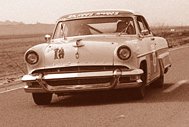
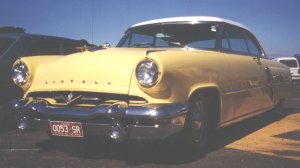 In 1952 the Capri became a product line in its own
right, the range comprising a four door sedan, a two door hardtop, and a convertible. It
is reputed to be the first car to use ball-joint front suspension, and was powered by
Ford's first overhead valve V-8, which produced 205 bhp from 5.2 litres. With
this power, and with some special-project help from Ford, the muscle Capris of the early
1950s had considerable competition success, particularly in the Carrera Panamericana,
a 2,000-mile road-race across eastern Mexico from near the Guatamelan border to just south
of the Mexican border with the USA.
In 1952 the Capri became a product line in its own
right, the range comprising a four door sedan, a two door hardtop, and a convertible. It
is reputed to be the first car to use ball-joint front suspension, and was powered by
Ford's first overhead valve V-8, which produced 205 bhp from 5.2 litres. With
this power, and with some special-project help from Ford, the muscle Capris of the early
1950s had considerable competition success, particularly in the Carrera Panamericana,
a 2,000-mile road-race across eastern Mexico from near the Guatamelan border to just south
of the Mexican border with the USA.
From 1956 until its (temporary) demise in 1960, the US Capri grew even bigger - wheelbase went up to 3.3 metres - while gaining fins, wheel skirts and increasing masses of chrome.
|
|
|
*******************************
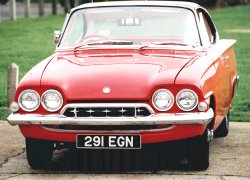
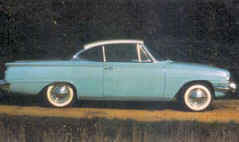 The Capri badge next appeared in
1961 on a British coupé, with styling evocative of the 1959 Thunderbird, based on the
Consul Classic 315. The Capri 335 had a 1340cc (56 bhp) or 1500cc
"Kent" 4-cylinder engine in either standard (59 bhp) or GT (87 bhp)
tune. Some 7,500 units were built before production ceased with the 1964 model.
The Capri badge next appeared in
1961 on a British coupé, with styling evocative of the 1959 Thunderbird, based on the
Consul Classic 315. The Capri 335 had a 1340cc (56 bhp) or 1500cc
"Kent" 4-cylinder engine in either standard (59 bhp) or GT (87 bhp)
tune. Some 7,500 units were built before production ceased with the 1964 model.
*******************************
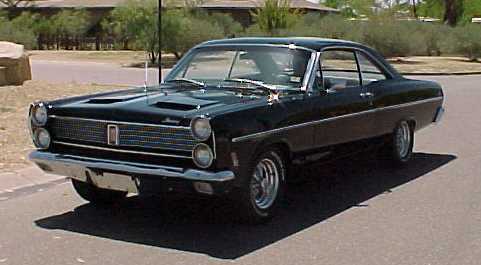 In the
mid-1960s the US Mercury Division produced a small number of Capri-badged Comets, but
they were little more than a trim variation, being technically similar to the parent car.
This is the 1967 model.
In the
mid-1960s the US Mercury Division produced a small number of Capri-badged Comets, but
they were little more than a trim variation, being technically similar to the parent car.
This is the 1967 model.
*******************************
In 1969 the "European" Capri was introduced, and became the best-known of them all. From 1969 to 1987, about 2 million units of this two-door sports coupé were built in Britain, Germany, Australia, and South Africa, in three main model designations.
Based on a Cortina chassis, with long-bonnet and short-tail bodywork reminiscent of the early Mustang, this car was delivered in a bewildering array of configurations. It was originally released with a 1300cc 4-cylinder single-carburettor engine with four-speed manual box, but in later models we find crossflow heads, OHC, multiple carbys, straight-four and V-6 engines with capacities up to 3100cc (and in South Africa you could even order a 4.5 litre V-8!), manual or automatic, and multiple trim and performance options. It was very successful in all types of competition.
*******************************
In 1979 the Mustang-based "Fox" Capri was released on the US market. It was available only as a hatchback, but with a variety of engines, including the 2.3 litre "Lima" 4-cylinder, the 2.8 litre "Cologne" V-6, the 3.3 litre pushrod straight-6, a new 3.8 litre V-6, or the 4.2 or 5 litre "Windsor" V-8. Production ceased in 1986.
*******************************
The 1989 SA Capri convertible was developed by Ford Australia to take advantage of favourable government export policies. Breaking with Capri tradition of front inline engine, rear drive, it was based on the transverse-engined front-drive Mazda 323 chassis, with a 2+2 body derived from the "Barchetta" concept car at the 1983 Frankfurt Motor Show, and with an interior by Italdesign. It introduced two features not found in previous Capris - fully independent rear suspension, and four-wheel disk brakes.
As first released, the SA Capri had a 1600cc EFI engine, either an atmospheric SOHC or a DOHC turbo. In 1990 the DOHC engine was adopted for the non-turbo version. A 5-speed manual transmission was standard, with a 3-speed auto optional on the non-turbo car. Other options included a steel hardtop and air-conditioning.
Exports of the SA-II started in mid-1990, the delay being caused by the need to comply with new USA air-bag legislation. Of some 67,000 units produced, most went to the USA in LHD form, while about 10,000 RHD cars were sold in Australia, and a small number went to south-east Asian countries. Although the same basic design was retained throughout its life, there were minor body and equipment changes; performance was enhanced with the XR-2 in 1991; a low-volume "styled" version called "Verde" was produced in 1991; and two variants were introduced in 1992: the economy "Barchetta" ("little boat"), and the Tickford-developed "Clubsprint" with performance modifications and streamlined body panels. In its final form in 1994, the Capri engine produced 100 bhp (atmo) and 132 bhp (turbo). Apart from the Consul Capri, it is the only Capri that doesn’t have a serious motor-sport history.
(See also "A brief history of the Capri convertible".)
*******************************
So - just what is a Capri? Well, that should be quite clear by now - it’s obvious that a Capri is a large/medium/small car in sedan/coupe/convertible configuration weighing somewhere between 1 and 2 tonnes, with a four/six/eight-cylinder engine driving the rear wheels except when it is front-wheel-drive. Sometimes it is a luxury cruiser, sometimes a family runabout. It has been a mighty racer and/or a fearsome rally car; it has also been just a car to enjoy. So... one thing the various models of Capri have in common is that they are all different from each other.
Another thing they have in common is that the Capri has usually been designed as an attention-grabber. This works. Regardless of whether you love or hate its styling, you have to admit that almost every Capri’s appearance is unforgettable.
*******************************
The Capri of the future is still an unknown, although some well-informed guesses are circulating about an inline four or V-6, 6-speed front-wheel drive design based on the Focus platform, with 2+2 coupé and cabriolet bodies, looking something like this:
It has been suggested that this car will debut as a design concept at the Frankfurt Motor Show in September 2003, with production commencing in 2006, or even earlier. While we should keep in mind that many a great concept been abandoned because of economic or political factors, and that nothing is certain until it happens, we should also also live in hope.
JC's home page
PC Users Group home page
Created 5 May 2003 : Last updated 18 July 2010.